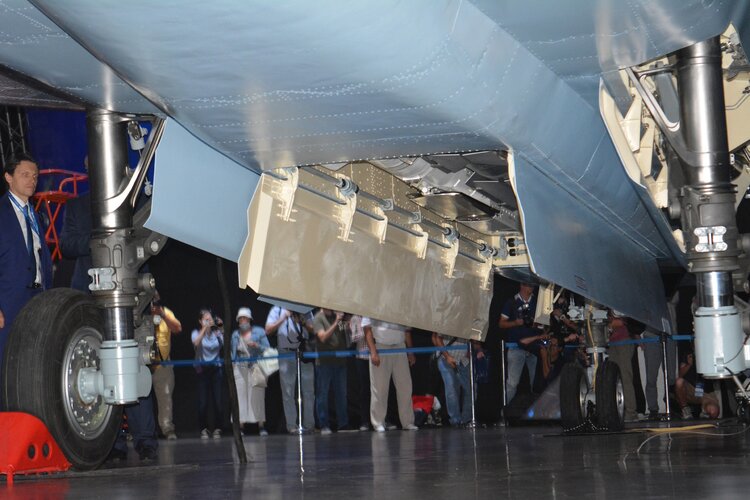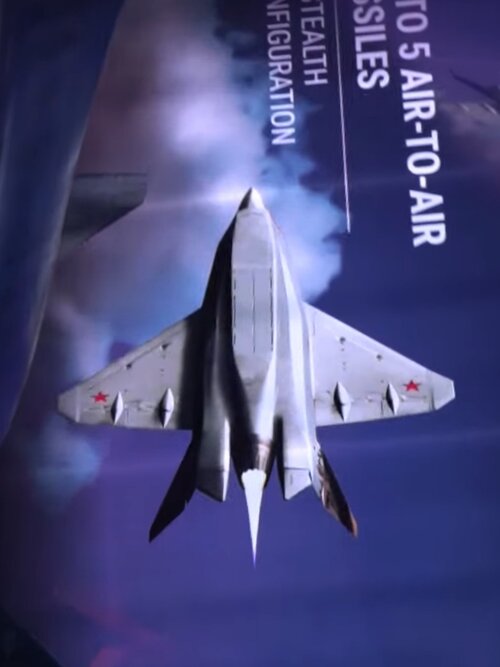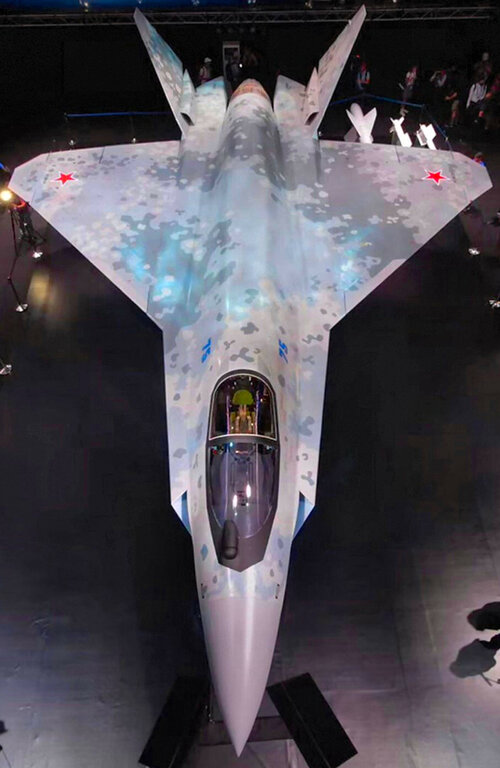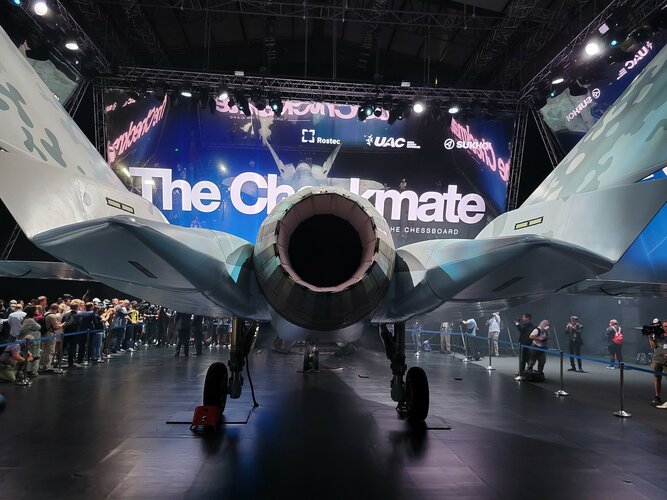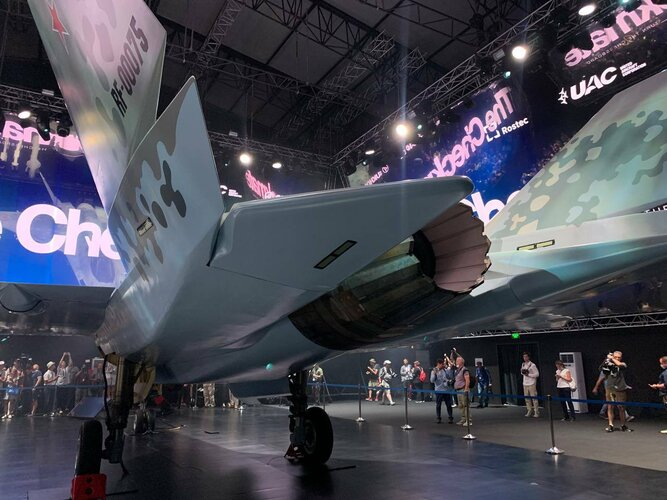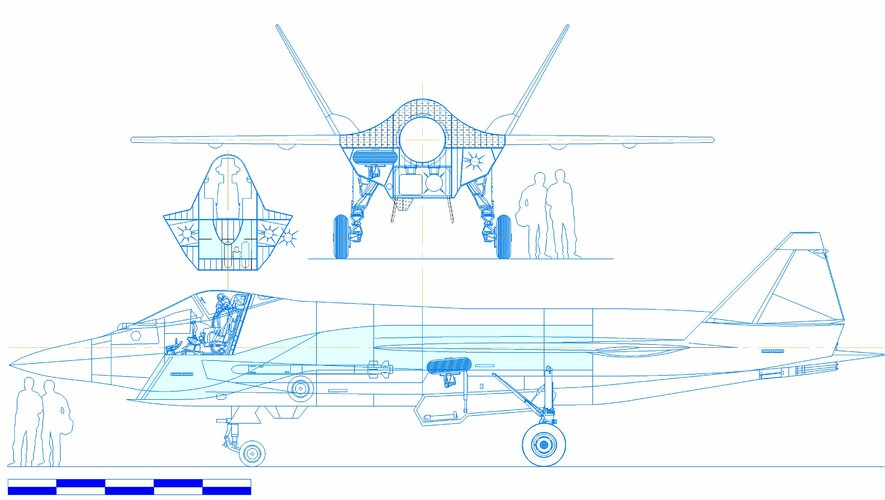Well, Salyut's AL-31FM3 was planned to have 15.4t thrust with 924 turbine diameter, 117(s) has diameter of 932, so 16t is entirely possible (why they didn't so in the first place?).Yes, that is what I mean. 117S is 14.5 tf, 117 is 15 tf, the supposed new version of 117 would be 16 tf.
You are using an out of date browser. It may not display this or other websites correctly.
You should upgrade or use an alternative browser.
You should upgrade or use an alternative browser.
Sukhoi T-75 LTS (CheckMate)
- Thread starter sublight_
- Start date
alejandro_
ACCESS: Restricted
- Joined
- 18 December 2006
- Messages
- 14
- Reaction score
- 23
LMFS said:Maybe we find some source somewhere...
I thought that at high G the relation is exponential, thus a reduction in G limit could provide important savings in weight. As seen in Paralay's diagram, the LTS is pretty big with large internal volume, which could explain 3000 km range.
Dsigner Miikhail Strelets mentioned in an interview the modular design in the LTS. The front section can be replaced for different versions. This could also affect the G limits.

"Шах и мат". Конструктор Стрелец: новый истребитель превзойдет все мировые аналоги
Главный конструктор ЛТС рассказывает об особенностях нового самолета Checkmate
LMFS]The landing gear and the g tolerance follow different requirements for different operational aspects that can be weighted differently. A beefed-up landing gear is not a huge contribution to weight said:but I'm not sure the landing gear the designers selected supports that, if you excuse the pun.
The landing gears reminds of the one used in the Su-57, but is it the same? Graphics created with both aircraft side by side do not show this. Note that the strut is different as well.
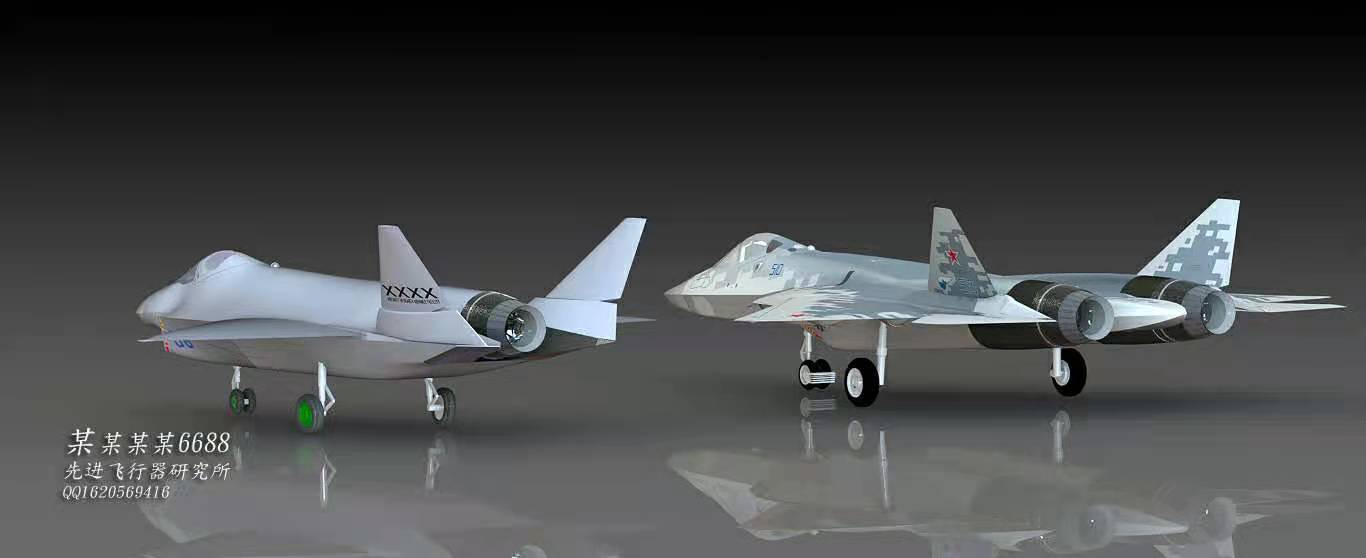
MiG-29K and Su-33.Now if I remember right the max sustained verticle g forces the mig 23 could pull was 8 g forces. What others were in this ballpark? Trying to get an intuitive idea of what the lts can do.
TMA1
ACCESS: Top Secret
- Joined
- 6 February 2021
- Messages
- 556
- Reaction score
- 857
Thanks!MiG-29K and Su-33.Now if I remember right the max sustained verticle g forces the mig 23 could pull was 8 g forces. What others were in this ballpark? Trying to get an intuitive idea of what the lts can do.
- Joined
- 27 December 2005
- Messages
- 17,748
- Reaction score
- 26,420
Now if I remember right the max sustained verticle g forces the mig 23 could pull was 8 g forces. What others were in this ballpark? Trying to get an intuitive idea of what the lts can do.
You are putting way too much emphasis on the 8g limit.
Example: Su-27. From the Flight Manual.
--
Maximum service G at design flight weight of 21,400 kg
G limit = 8.0 at M < 0.85
G limit = 6.5 at 0.85 < M > 1.25
G limit = 7.0 at M > 1.25
For weights differing from the design flight weight, G is
established from the conditions :
Weight x G max = 171,000kg at M < 0.85, G limit = 9.0
Weight x G max = 139,000kg at 0.85 < M > 1.25, G limit= 7.0
Weight x G max = 150,000kg at M > 1.25, G limit = 7.5
The Su-27 can only pull 9G at under Mach 0.85 and at a weight of 19,000kg or less (171,000/9=19,000kg). Working back from the normal takeoff weight of 23250 kg we need to lose 4250kg, as we want to keep our 4 AAMs and ammo that means we must be down to around 840kg fuel, just 17% of our (already reduced) fuel load, to be allowed to pull 9G.
--
In reality, turns above 5-7g are unusual except in the "oh crap, I'm going to die" situation. Given a relative lack of thrust, until Izdeliye 30 is fitted, 9g turns will just be a way to bleed speed too quickly and lose.
TMA1
ACCESS: Top Secret
- Joined
- 6 February 2021
- Messages
- 556
- Reaction score
- 857
More thanks! You guys know your stuff.Now if I remember right the max sustained verticle g forces the mig 23 could pull was 8 g forces. What others were in this ballpark? Trying to get an intuitive idea of what the lts can do.
You are putting way too much emphasis on the 8g limit.
Example: Su-27. From the Flight Manual.
--
Maximum service G at design flight weight of 21,400 kg
G limit = 8.0 at M < 0.85
G limit = 6.5 at 0.85 < M > 1.25
G limit = 7.0 at M > 1.25
For weights differing from the design flight weight, G is
established from the conditions :
Weight x G max = 171,000kg at M < 0.85, G limit = 9.0
Weight x G max = 139,000kg at 0.85 < M > 1.25, G limit= 7.0
Weight x G max = 150,000kg at M > 1.25, G limit = 7.5
The Su-27 can only pull 9G at under Mach 0.85 and at a weight of 19,000kg or less (171,000/9=19,000kg). Working back from the normal takeoff weight of 23250 kg we need to lose 4250kg, as we want to keep our 4 AAMs and ammo that means we must be down to around 840kg fuel, just 17% of our (already reduced) fuel load, to be allowed to pull 9G.
--
In reality, turns above 5-7g are unusual except in the "oh crap, I'm going to die" situation. Given a relative lack of thrust, until Izdeliye 30 is fitted, 9g turns will just be a way to bleed speed too quickly and lose.
Sorry if that has already been mentionned across 26 pages of thread - do we have that bay dimensions ?
Pretty fun to see "missile bays" returning on interceptors and tactical fighters. As in the good old days of the CF-105, F-105 and F-106.
Pretty fun to see "missile bays" returning on interceptors and tactical fighters. As in the good old days of the CF-105, F-105 and F-106.
Acatomic
ACCESS: Secret
- Joined
- 18 October 2020
- Messages
- 245
- Reaction score
- 580
Wing is the same as in Su-57?T-75
Mirage4000-5
ACCESS: Restricted
- Joined
- 11 March 2021
- Messages
- 7
- Reaction score
- 17
Last edited:
- Joined
- 27 December 2005
- Messages
- 17,748
- Reaction score
- 26,420
If you read any Radar textbook you will know that there are things called Probability of Detection and it's related to radar detection range in a manner that whether a radar "know" What it was detected. the R50 or Range at when probability of Detection is 50% Means the radar picked a target but only 50% sure it's a real target.
Then the radar get closer to target or by some means of processing (e.g pulse integration), the signal strength improves where the radar can be 90% sure that it is picking up a target. The range of when this happen is called as R90.
These two probabilities and the range figure associated with them shows when your radar can detect a target and in case of 90% when it can be locked or constantly tracked for engagement (Shooting missiles etc) For Early warning radar you may have R85 which correspond to the range where the radar is 85% sure that it is a real target, not a false alarm.
Having detection probability in calculations Helps making it more definitive like If i mention 90% or R90. It is the range where the Radar can lock on target and engage it. the 50% one is longer but it's not telling you whether your radar can really track or even sure that contact is a real target.
Now what is that 250 km ? Is it R50 or R90. If it's R50 then the target can be detected but may not necessarily be able to be engaged at that range. If it R90 then it is likely be locked on and engaged.
And what condition that 250 Km was taken ?, in What modes ? Radar have multiple modes which may have different dwell time and therefore range. My first calculation back then use 0.025 seconds of dwell which is typical for airborne fighter radar. But more range can be gained by increasing dwell time but in cost of longer scanning time or reduced scanning area.
This isn't actually quite correct.
" the R50 or Range at when probability of Detection is 50% Means the radar picked a target but only 50% sure it's a real target."
No it isn't that complicated. It is simply the range at which there is a 50% probability of detection of a given target. The target is detected or it isn't, there's no "50% detected" targets like there's no "a little bit pregnant" women.
When testing an AI radar you fly intercepts against a specific target and measure the range at which detection occurs. The detection range each time will vary depending on many variables. How wide an angle are you scanning? 1 bar or 4 bar scan pattern? What's the exact angles, speeds, altitudes of fighter and target? You can run the numbers and calculate typical probabilities at different ranges.
The range of a radar is therefore never exact. If a radar is quoted as having a range of 100km, it doesn't behave like a tripwire, like there's a fighter at 101km, invisible, and then it hit 100km and blammo, there it is on the screen. You start off with a low chance of detection and it gets greater the closer you get to the target. 10% of the time you won't detect it until even closer than the 90% range.
If you get a steer from GCI or AWACS as to where the target is and point your radar at it in a focused, small angle scan, you'll increase the probability of detection at a longer range than if you scan a 90 degree sector with a 4 bar scan.
Quoting the 50% probability range makes your radar seem to have longer range than if you quote the 90% probability range.
The point stands however that a range figure in isolation is hard to compare to another number. "In tests the radar detected a target at 250km", sure, but out of 20 tests, what was the 90% probability range demontrated? 200km? 180km? DId they just get lucky one time? The customer wanted 130km range at what probability of detection? 10%? 99%?
LMFS
ACCESS: Top Secret
- Joined
- 19 March 2019
- Messages
- 534
- Reaction score
- 880
Yeah I understood that, and I agree it is a possibility. What I mean is that it is not a given that they would degrade the basing capabilities of the plane because of the weight out effort, they may have different priorities and use the weight budget they have available for the requirements they consider more critical. A 9 g to 8 g restriction is not good but is not critical IMHO, to require immaculate runways to operate can be a critical issue in wartime.A very aggressive weight reduction programme usually follows a path of every single component being subjected to specific design study, and re-study, to constantly shave weight. It also is likely that each component is specifically designed in a bespoke manner for just that platform, and unlikely to be a modification or re-use of existing components.
In BVR the first thing to do is to change course to deplete the energy of the missile before it can get close to you. You need to turn quick (it can take many seconds depending on the speed, altitude and turning characteristics of the plane) and keep your speed as high as possible. The first part relates to the airframe, the second to the propulsion. So they are not mutually excluding, you can have the turning capability and then you may decide to use it one way or another, depending on what is best for a particular engagement and what your engine allows. I recall that the MiG-29 is considered to be able to sustain 9 g without losing speed, so that may be a good reference and I thing the LTS should no be far from that. Of course, when turning takes long time it means the air is little dense and 9 g would never be reached. At medium altitudes the restriction would be reached with ease and, in fact, I have not seen many EM diagrams for the most modern planes, where wing load has become much lower and lift augmentation features are common. Probably new planes reach 9 g in many more situations than it was the case in the previous generation.My understanding is that repeated course changes are useful for kinematically defeating missiles (because most AAM/SAM have less average sustained thrust, and bleed energy faster in a turn due to needing a higher angle of attack). Because an aircraft going faster covers a larger distance, any change in course leads to a larger change in lead-course required for the intercepting missile to meet it... and this robs energy from the missile by forcing it to change course repeatedly.
So an aircraft going Mach 1.5 and pulling 8 gees can exhaust a missiles with a peak speed of make 4.5 pulling 20 gees... I recall one interview regarding the PAK-FA requirement stated that sustained supersonic manoeuvrability was a major requirement for defeating surface to air missiles.
So optimal subsonic turn times may actually be much less important these days than energy retention in a turn (in fact, I believe most modern WVR dogfighting techniques also focus on energy retention and position over maximising initial turn rates).
Exactly, there is a wide gap between different planes. But taking an existing plane and use it as reference for another newer one with similar layout and characteristics is quite valid IMHO.
- MiG-29: 18480 – 10900 – 3240 – 100 = 4240 kg, weapon 2220 kg (12%)
- MiG-35: 23500 – 12100 – 4800 – 100 = 6500 kg (27%)
- F-16: 21772 – 8910 – 3228 – 100 = 9534 kg (43.8% - weapons plus external tanks)
- Rafal: 24500 – 9625 – 4700 – 100 = 10075 kg, weapons 20 Mk82 bombs, 5000 kg (20%), (41% - weapons plus external tanks)
- Typhoon: 21000 – 11000 – 4223 – 100 = 5677 kg (27%)
- F-35A: 31750 – 13290 – 8278 – 100 = 10082 kg, weapons 8165 kg (26%), (32% - weapons plus external tanks, which are not present)
- F-22: 33906 – 19660 – 9367 – 100 = 4779 kg, weapons 2016 kg (6%)
BTW, are you sure the F135 and the AL-31 family have the same diameter? The F-35 model seems a bit small to me...
It is in any way clearly visible how high the LTS rests on the landing gear, quite striking in fact. That should allow to load the ventral bays with ease. It is also clear what a thick plane the F-35 is.
Well, it is based on the AL-31F so they are limited in what they can do, they can work with materials and control mainly, but probably they also don't want to throw into that export material all their best tricks. They also need experience and further learning to squeeze more power from the layout without compromising reliability. Izd. 117 five years ago was not material for export, now it seems even an advanced variant of it will be offered without big issues.Well, Salyut's AL-31FM3 was planned to have 15.4t thrust with 924 turbine diameter, 117(s) has diameter of 932, so 16t is entirely possible (why they didn't so in the first place?).
I think it is linear, but regardless it can have a big impact if the force arms are long and the area affected is extensive. The plane is quite big, for me the fuselage is indeed capable of holding the needed amount of fuel for that range. Dorsal tank alone seems huge, 3-4 t probably.I thought that at high G the relation is exponential, thus a reduction in G limit could provide important savings in weight. As seen in Paralay's diagram, the LTS is pretty big with large internal volume, which could explain 3000 km range.
Yeah I saw that and found it very interesting. If you notice, the cockpit section itself is literally that of the Su-57, not only the glazing but also the nose portion and the structure after the lantern, there are changes of convexity in the fuselage that reveal that. They did design the plane with that recycling approach to attain a very low price and, if the claims are true, it seems they succeeded. It is interesting in any case to see what strategies did they use and how intensively did they implement them, they went very far with the recycling of Su-57 parts indeed...Dsigner Miikhail Strelets mentioned in an interview the modular design in the LTS. The front section can be replaced for different versions. This could also affect the G limits.
So, for an unmanned version probably they put a different forward fuselage without cockpit, for instance. But how would that affect the overload characteristics of the plane is not clear to me. What it could indeed happen is that the CoG may be affected...
I basically agree that this is not the end of the world, it is rather commercially inconvenient to know that it will appear in any comparison your potential customers do as a minus instead of as a plus or at least a neutral aspect, that opens gaps for opponents of your proposal to criticise it, even when it is rather a political thing. +9/-3 g design is essentially a standard.In reality, turns above 5-7g are unusual except in the "oh crap, I'm going to die" situation. Given a relative lack of thrust, until Izdeliye 30 is fitted, 9g turns will just be a way to bleed speed too quickly and lose.
That being said, the situation you describe is what you design fighters for, so it is not necessarily a good thing to start the fight with even minor shortcomings vs your rivals. The kind of turns that the current propulsion proposals can sustain is difficult to say I guess, the excess power will probably not be very far off from that of the MiG-29...
Wow that is very deep indeed... 70 cm probably?Don't think I saw this picture here. It is a very good one of the open central weapons bay.
Since they hold the Su-57 type of ordnance, they should be ca. 4.5 x 1.15 m, maybe Paralay has more precise dimensionsSorry if that has already been mentionned across 26 pages of thread - do we have that bay dimensions ?
- Joined
- 28 January 2008
- Messages
- 1,016
- Reaction score
- 2,207
Very nice artwork! Kudos!
- Joined
- 28 January 2008
- Messages
- 1,016
- Reaction score
- 2,207
Very interesting 90 deg gearbox for the weapons bay door drive, seems to have redundant drive inputs, I am an actuation geek.Don't think I saw this picture here. It is a very good one of the open central weapons bay.
One conspicuous departure from the Su-57 is that they've absolutely festooned this thing with low-intensity formation lights! Here we have another pair under the intake, anybody counted them all yet? It's a wonder they haven't put any inside the nozzle 
EDIT: I make it 20, where the Su-57 has none - talk about a Christmas tree!
EDIT: I make it 20, where the Su-57 has none - talk about a Christmas tree!
Last edited:
Interesting theory, although the low intensity electro-luminescent lights used here seem inappropriate for that task - they were specifically designed to be so weak as to be only observable from up close.
- Joined
- 29 November 2010
- Messages
- 1,775
- Reaction score
- 3,479
question
does an aircraft need an IRST if it already has an EOTS? I assume an EOTS is basically an IRST + FLIR
does an aircraft need an IRST if it already has an EOTS? I assume an EOTS is basically an IRST + FLIR
Yes, because EOTS have limited angles for lookup.question
does an aircraft need an IRST if it already has an EOTS? I assume an EOTS is basically an IRST + FLIR
- Joined
- 27 December 2005
- Messages
- 17,748
- Reaction score
- 26,420
EOTS is an F-35 specific item which combines IRST and FLIR functions, but it is limited in elevation due to the location. You might want to have another device on top of the nose.
Yup, a ventral EO system with FoV limited in elevation cannot really be used to support close combat (Russian fighters often rely on IR tracking + laser ranging for accurate gunnery). There's also the fact that for detection of distant air targets you want a LWIR sensor, while for imaging of ground targets MWIR is preferable (EOTS is MWIR only).
So if you want to avoid certain compromises, having separate devices for these functions is inevitable.
So if you want to avoid certain compromises, having separate devices for these functions is inevitable.
ADC411
ACCESS: Restricted
- Joined
- 18 August 2020
- Messages
- 16
- Reaction score
- 55
Going off the existence of KOEPS-75 alongside the traditional IRST, in addition to the low target acquisition cost for the aircraft, I believe that KOEPS-75 is not intended to be as sophisticated or capable as the F-35's EOTS. It's likely a simple TV/FLIR system, with capabilities similar to ground targeting pods prevalent on current 4th gen aircraft, whose image data may be able to be sensor fused with that from the IRST to provide a roughly similar overall capability as EOTS, but with perhaps somewhat more utility against aerial threats due to sensor positioning.
As such, referring to the KOEPS by itself as an EOTS would be drawing a false comparison between the two systems, at least in regards to the comprehensiveness and sophistication of the their respective sensor suits.
Of course, that's all just an assumption on my part. We'll need to wait to receive more information.
As such, referring to the KOEPS by itself as an EOTS would be drawing a false comparison between the two systems, at least in regards to the comprehensiveness and sophistication of the their respective sensor suits.
Of course, that's all just an assumption on my part. We'll need to wait to receive more information.
- Joined
- 24 November 2008
- Messages
- 1,549
- Reaction score
- 2,612
Hmm, that aerodynamic layout still puzzles me.
The absence of horizontal tails in combination with those relatively little canted vertical tails is quite unique. I cannot recall any configuration out there with a comaprable wing / control surface layout. Even if those (presumably) split air brakes act as control surfaces as well I cannot imagine they would provide the same pitch control authority as full sized horizontal tails. Would it be viable without thrust vectoring?
Any thoughts?
The absence of horizontal tails in combination with those relatively little canted vertical tails is quite unique. I cannot recall any configuration out there with a comaprable wing / control surface layout. Even if those (presumably) split air brakes act as control surfaces as well I cannot imagine they would provide the same pitch control authority as full sized horizontal tails. Would it be viable without thrust vectoring?
Any thoughts?
Attachments
Avimimus
ACCESS: Top Secret
- Joined
- 15 December 2007
- Messages
- 2,426
- Reaction score
- 909
Hmm, that aerodynamic layout still puzzles me.
The absence of horizontal tails in combination with those relatively little canted vertical tails is quite unique. I cannot recall any configuration out there with a comaprable wing / control surface layout. Even if those (presumably) split air brakes act as control surfaces as well I cannot imagine they would provide the same pitch control authority as full sized horizontal tails. Would it be viable without thrust vectoring?
Any thoughts?
Hmm... one does get the impression that 2d thrust vectoring is important for this aircraft, however... if one is willing to give up stability... I suppose getting into a pitching moment is always possible - just not recovering from it
Mocking it up in X-plane should give a decent idea for the subsonic flight regime (although I'm not sure how well it handles the tail being so deeply shrouded by the wings at high AoA)? If someone has access to a full CFD suite with tools for calculating pitch efficacy they could probably do better?
Acatomic
ACCESS: Secret
- Joined
- 18 October 2020
- Messages
- 245
- Reaction score
- 580
Maybe LM found a way to combine both LWIR and MWIR:Yup, a ventral EO system with FoV limited in elevation cannot really be used to support close combat (Russian fighters often rely on IR tracking + laser ranging for accurate gunnery). There's also the fact that for detection of distant air targets you want a LWIR sensor, while for imaging of ground targets MWIR is preferable (EOTS is MWIR only).
So if you want to avoid certain compromises, having separate devices for these functions is inevitable.
@VTOLicious and @Avimimus
Don't forget that the tail configuration acts as an ejector, drawing a mass flow of air thanks to the nozzle output. So those little trim/elevons are fed with enough airstream in cruise configuration and may even act in-lieu of thrust vectoring.
Then it's a deltas wing and the V-tail are also sur-elevated, what contributes to the pitch moment.
Don't forget that the tail configuration acts as an ejector, drawing a mass flow of air thanks to the nozzle output. So those little trim/elevons are fed with enough airstream in cruise configuration and may even act in-lieu of thrust vectoring.
Then it's a deltas wing and the V-tail are also sur-elevated, what contributes to the pitch moment.
Acatomic
ACCESS: Secret
- Joined
- 18 October 2020
- Messages
- 245
- Reaction score
- 580
Nice catch by Zen432 from http://paralay.iboards.ru/viewtopic.php?p=645152#p645152
It shows the landing gear comparison between LTS and F-14 and it's basically identical.
It shows the landing gear comparison between LTS and F-14 and it's basically identical.
- Joined
- 11 February 2007
- Messages
- 2,567
- Reaction score
- 4,380
@VTOLicious and @Avimimus
Don't forget that the tail configuration acts as an ejector, drawing a mass flow of air thanks to the nozzle output. So those little trim/elevons are fed with enough airstream in cruise configuration and may even act in-lieu of thrust vectoring.
I was thinking much the same, but also wondering whether thrust vectoring responds fast enough, precisely enough for stabilising an unstable aircraft, as opposed to being used to drive deliberate change in pitch/roll/yaw, which isn't nearly as time sensitive. Anyone know the answer from existing thrust vectoring designs?
LMFS
ACCESS: Top Secret
- Joined
- 19 March 2019
- Messages
- 534
- Reaction score
- 880
I have checked the compared dimensions of the LTS and Su-57 and indeed the rough measures given by Paralay (18x12 m) seem ok, I have to admit that I am surprised at the size of the plane, but using the same wings and many other elements of the Su-57 this size makes more sense and will have beneficial effects in costs, for both planes in fact.
Does anybody know of any other time when such an attempt has been done of commonality between twin heavy and light single engined fighter sharing so many elements? This is taking the hi-lo approach to a whole new level...
As to the tail issue, those horizontal tail surfaces should indeed have enough pitch authority for trimming and keeping the plane stable, at least. TVC has roughly the same deflection speed of aero surfaces from what I know and Russians have extensive experience with it already, at some moment they may decide to use it as main pitching element. The combination of those two should allow to control the plane without problems. BTW I am assuming the plane has relaxed stability, someone has analysed that in detail?
Does anybody know of any other time when such an attempt has been done of commonality between twin heavy and light single engined fighter sharing so many elements? This is taking the hi-lo approach to a whole new level...
As to the tail issue, those horizontal tail surfaces should indeed have enough pitch authority for trimming and keeping the plane stable, at least. TVC has roughly the same deflection speed of aero surfaces from what I know and Russians have extensive experience with it already, at some moment they may decide to use it as main pitching element. The combination of those two should allow to control the plane without problems. BTW I am assuming the plane has relaxed stability, someone has analysed that in detail?
Last edited:
@VTOLicious and @Avimimus
Don't forget that the tail configuration acts as an ejector, drawing a mass flow of air thanks to the nozzle output. So those little trim/elevons are fed with enough airstream in cruise configuration and may even act in-lieu of thrust vectoring.
I was thinking much the same, but also wondering whether thrust vectoring responds fast enough, precisely enough for stabilising an unstable aircraft, as opposed to being used to drive deliberate change in pitch/roll/yaw, which isn't nearly as time sensitive. Anyone know the answer from existing thrust vectoring designs?
Absolutely, on this video, both at the beginning of the video (about 5 seconds in) and between 45 seconds and 1 minute you can see two types of thrust vectoring nozzles work quickly and precisely. I don't know what they're called, one moves the entire nozzle (as used in AL-31 derivatives) and the other only moves the petals (as used in RD-33 derivatives). Either way, they both seem to be suitable for it.
For me the question has always been whether or not there will be enough control authority at low thrust.
As for commonality between the Su-57 and this, has it been confirmed that they will share as much of the airframe as the mockup seems to? It could be that they threw the wings, rudders, etc on it as they had those available and the final design or construction of the real airframe isn't finalized, and I'm pretty sure there's still plenty of time to finish designing, building and do ground tests before the first flight in 2023.
- Joined
- 27 March 2006
- Messages
- 1,873
- Reaction score
- 1,620
I have checked the compared dimensions of the LTS and Su-57 and indeed the rough measures given by Paralay (18x12 m) seem ok, I have to admit that I am surprised at the size of the plane, but using the same wings and many other elements of the Su-57 this size makes more sense and will have beneficial effects in costs, for both planes in fact.
From the very beginning, when we saw it under the tarpaulin/cover being towed, it was obvious to me at least that this plane has a size footprint (length and span) squarely in the MiG-29 size range.
I am wondering about a naval version.
- Joined
- 27 March 2006
- Messages
- 1,873
- Reaction score
- 1,620
Another thing I am wondering about is MiG. There have been various images of their light fighter concepts over the years.
I am not talking of the models shown at MAKS 21.
I wonder if they are still quietly working on getting that done, or whether all resources are directed to the stated MiG-31 replacement?
I am not talking of the models shown at MAKS 21.
I wonder if they are still quietly working on getting that done, or whether all resources are directed to the stated MiG-31 replacement?
tequilashooter
ACCESS: Top Secret
- Joined
- 1 January 2021
- Messages
- 699
- Reaction score
- 895
I wonder if they are still quietly working on getting that done, or whether all resources are directed to the stated MiG-31 replacement?
KRET seems to still be a firm believer
However, the theory of "pairing" does not work here, because there is a third machine - the super heavy MiG-31. A welded airframe made of steel (they are not made abroad) and a pair of powerful D-30F6 engines (unique in their aggregate characteristics) allow this interceptor to maintain a speed record among consumers - over 3000 km / h. To replace the MiG-31, an even faster MiG-41 is being developed, capable of speeds 4-4.3 times higher than the sound one. At the same time, judging by the statements of the UAC representatives, the corporation is determined to continue the development of light fighters as well.
I will probably have to wait a few days to a week later after the airshow for more new articles from promweekly.ru
MiG is in a rather difficult economic situation. I would not expect him to implement any large-scale projects.
- Joined
- 11 February 2007
- Messages
- 2,567
- Reaction score
- 4,380
That doesn't actually answer the question. If you watch the first couple of seconds of the video you'll see the Flanker's horizontal tails moving twice as fast in pitch as the nozzle can. It's almost a case of if you can see it move it's too slow. The FCS is assessing what to do to stop the aircraft departing due to instability on processing cycles of probably around 10ms. This is faster than a human pilot can process, and you need to have the controls respond just as fast as the FCS. We're talking very small, fast twitches of the controls on top of any manouevre being commanded.@VTOLicious and @Avimimus
Don't forget that the tail configuration acts as an ejector, drawing a mass flow of air thanks to the nozzle output. So those little trim/elevons are fed with enough airstream in cruise configuration and may even act in-lieu of thrust vectoring.
I was thinking much the same, but also wondering whether thrust vectoring responds fast enough, precisely enough for stabilising an unstable aircraft, as opposed to being used to drive deliberate change in pitch/roll/yaw, which isn't nearly as time sensitive. Anyone know the answer from existing thrust vectoring designs?
Absolutely, on this video, both at the beginning of the video (about 5 seconds in) and between 45 seconds and 1 minute you can see two types of thrust vectoring nozzles work quickly
Similar threads
-
MAKS 2021 Airshow General News Topic
- Started by overscan (PaulMM)
- Replies: 35

